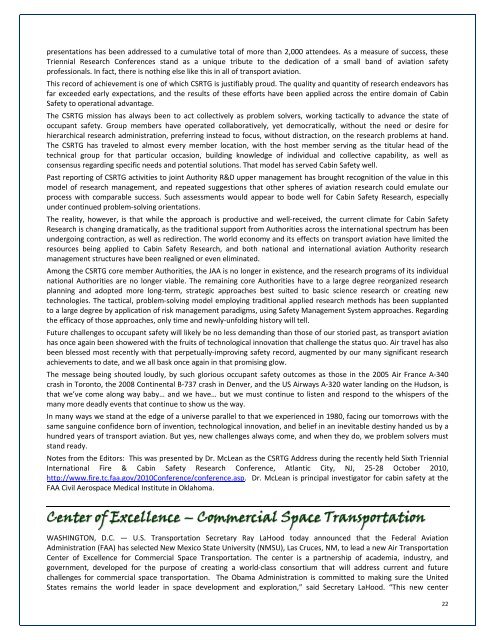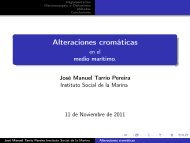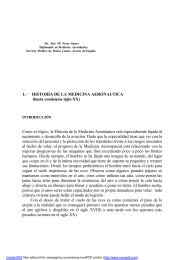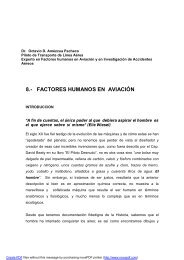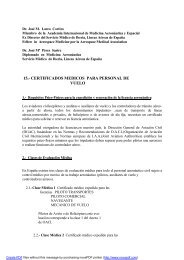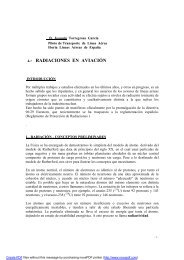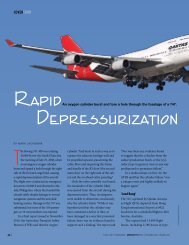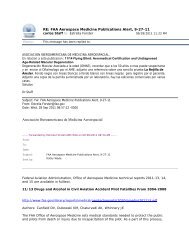AIMA Boletin Vol11 No2 (Diciembre/2010) - SEMA
AIMA Boletin Vol11 No2 (Diciembre/2010) - SEMA
AIMA Boletin Vol11 No2 (Diciembre/2010) - SEMA
Create successful ePaper yourself
Turn your PDF publications into a flip-book with our unique Google optimized e-Paper software.
presentations has been addressed to a cumulative total of more than 2,000 attendees. As a measure of success, these<br />
Triennial Research Conferences stand as a unique tribute to the dedication of a small band of aviation safety<br />
professionals. In fact, there is nothing else like this in all of transport aviation.<br />
This record of achievement is one of which CSRTG is justifiably proud. The quality and quantity of research endeavors has<br />
far exceeded early expectations, and the results of these efforts have been applied across the entire domain of Cabin<br />
Safety to operational advantage.<br />
The CSRTG mission has always been to act collectively as problem solvers, working tactically to advance the state of<br />
occupant safety. Group members have operated collaboratively, yet democratically, without the need or desire for<br />
hierarchical research administration, preferring instead to focus, without distraction, on the research problems at hand.<br />
The CSRTG has traveled to almost every member location, with the host member serving as the titular head of the<br />
technical group for that particular occasion, building knowledge of individual and collective capability, as well as<br />
consensus regarding specific needs and potential solutions. That model has served Cabin Safety well.<br />
Past reporting of CSRTG activities to joint Authority R&D upper management has brought recognition of the value in this<br />
model of research management, and repeated suggestions that other spheres of aviation research could emulate our<br />
process with comparable success. Such assessments would appear to bode well for Cabin Safety Research, especially<br />
under continued problem‐solving orientations.<br />
The reality, however, is that while the approach is productive and well‐received, the current climate for Cabin Safety<br />
Research is changing dramatically, as the traditional support from Authorities across the international spectrum has been<br />
undergoing contraction, as well as redirection. The world economy and its effects on transport aviation have limited the<br />
resources being applied to Cabin Safety Research, and both national and international aviation Authority research<br />
management structures have been realigned or even eliminated.<br />
Among the CSRTG core member Authorities, the JAA is no longer in existence, and the research programs of its individual<br />
national Authorities are no longer viable. The remaining core Authorities have to a large degree reorganized research<br />
planning and adopted more long‐term, strategic approaches best suited to basic science research or creating new<br />
technologies. The tactical, problem‐solving model employing traditional applied research methods has been supplanted<br />
to a large degree by application of risk management paradigms, using Safety Management System approaches. Regarding<br />
the efficacy of those approaches, only time and newly‐unfolding history will tell.<br />
Future challenges to occupant safety will likely be no less demanding than those of our storied past, as transport aviation<br />
has once again been showered with the fruits of technological innovation that challenge the status quo. Air travel has also<br />
been blessed most recently with that perpetually‐improving safety record, augmented by our many significant research<br />
achievements to date, and we all bask once again in that promising glow.<br />
The message being shouted loudly, by such glorious occupant safety outcomes as those in the 2005 Air France A‐340<br />
crash in Toronto, the 2008 Continental B‐737 crash in Denver, and the US Airways A‐320 water landing on the Hudson, is<br />
that we’ve come along way baby… and we have… but we must continue to listen and respond to the whispers of the<br />
many more deadly events that continue to show us the way.<br />
In many ways we stand at the edge of a universe parallel to that we experienced in 1980, facing our tomorrows with the<br />
same sanguine confidence born of invention, technological innovation, and belief in an inevitable destiny handed us by a<br />
hundred years of transport aviation. But yes, new challenges always come, and when they do, we problem solvers must<br />
stand ready.<br />
Notes from the Editors: This was presented by Dr. McLean as the CSRTG Address during the recently held Sixth Triennial<br />
International Fire & Cabin Safety Research Conference, Atlantic City, NJ, 25‐28 October <strong>2010</strong>,<br />
http://www.fire.tc.faa.gov/<strong>2010</strong>Conference/conference.asp. Dr. McLean is principal investigator for cabin safety at the<br />
FAA Civil Aerospace Medical Institute in Oklahoma.<br />
Center of Excellence – Commercial Space Transportation<br />
WASHINGTON, D.C. — U.S. Transportation Secretary Ray LaHood today announced that the Federal Aviation<br />
Administration (FAA) has selected New Mexico State University (NMSU), Las Cruces, NM, to lead a new Air Transportation<br />
Center of Excellence for Commercial Space Transportation. The center is a partnership of academia, industry, and<br />
government, developed for the purpose of creating a world‐class consortium that will address current and future<br />
challenges for commercial space transportation. The Obama Administration is committed to making sure the United<br />
States remains the world leader in space development and exploration,” said Secretary LaHood. “This new center<br />
22


